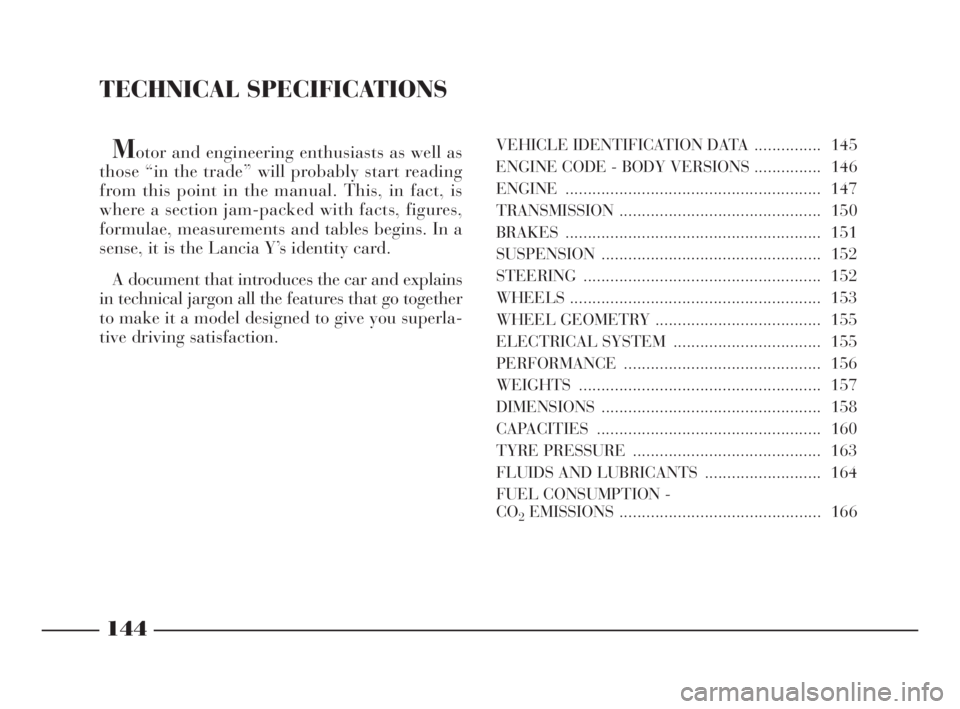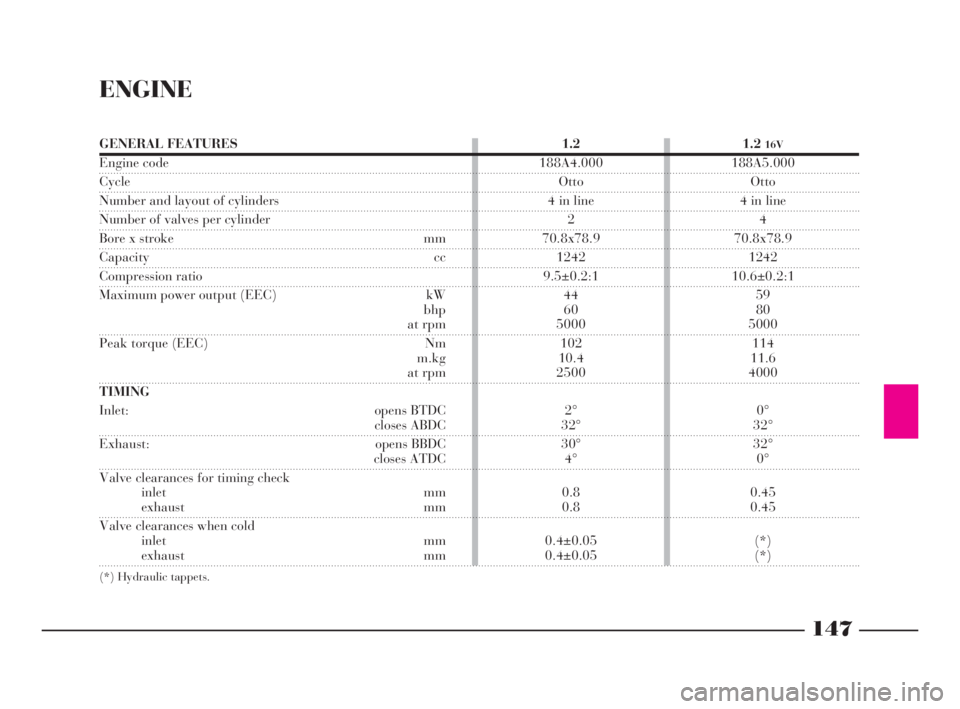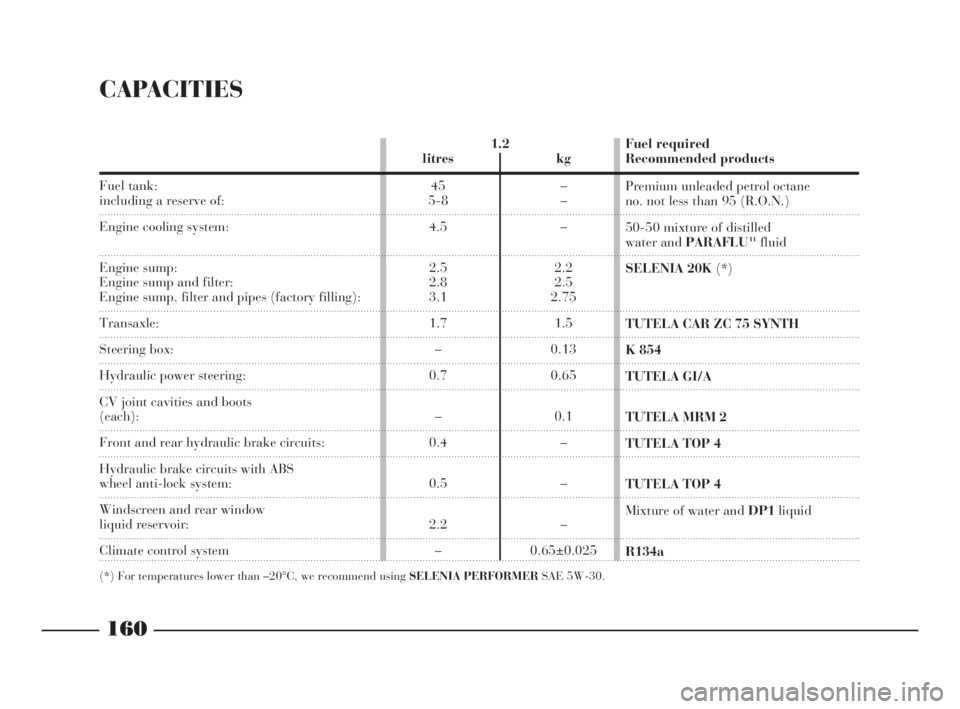engine Lancia Ypsilon 2002 Owner handbook (in English)
[x] Cancel search | Manufacturer: LANCIA, Model Year: 2002, Model line: Ypsilon, Model: Lancia Ypsilon 2002Pages: 191, PDF Size: 2.45 MB
Page 144 of 191

141
G
IMPORTANTCars with optional
“Kaleidos” options (non-standard
personalised paint colours), can be re-
paired in exactly the same way as
other cars painted with standard
colours at your LANCIA Dealership.To wash the car properly:
1)Remove the aerial from the roof
to prevent damaging it when washing
the car in an automatic carwash.
2)Wet the body using a low pressure
jet of water.
3)Wipe a sponge with a slightly
soapy solution over the bodywork,
frequently rinsing the sponge.
4)Rinse well with water and dry
with a jet of air or a chamois leather.
When drying the car, be careful to
get at those parts which are not so
easily seen e.g. the door frames, bon-
net and around the headlights where
water can most readily collect. You
are advised not to take the car into a
closed area immediately, but to leave
it out in the open so any water left can
evaporate more easily.
Do not wash the car after it has been
parked in the sun or while the bonnet
is hot: it could take the shine off the
paint.
External plastic parts must be
cleaned following the usual car wash-
ing procedure. As far as possible avoid parking your
car under trees; the resinous sub-
stances which often drop from certain
types of trees could dull the paint and
increase the possibility of rusting.
IMPORTANTBird droppings must
be washed off immediately and with
great care as their acid is particularly
aggressive.
Detergents pollute water.
For this reason, the car
must be washed in an area
equipped for the collection and
purification of the liquids used
while washing.
IMPORTANTWashing is to be car-
ried out with the engine cold and the
ignition key on STOP. After washing
make sure that the various protections
(rubber sheaths and other guards)
have not moved from their positions
or been damaged.
4C120-143 ING 11-03-2008 12:01 Pagina 141
Page 145 of 191

Detergents pollute water.
The car must therefore be
washed in an area
equipped for the collection and
purification of the liquids used
while washing.
IMPORTANTThe car should be
washed while the engine is cold and
with the ignition key at STOP. After
washing the car, make sure that the
various protections (e.g. rubber boots
and various guards) have not been re-
moved or damaged.
142
G
Windows
Use specific window cleaners to
clean the windows. Use very clean
cloths to avoid scratching the glass or
damaging its transparency.
IMPORTANTTo prevent damage
to the electric heater elements, wipe
the inside of the heated rear window
gently in the same direction as the el-
ements.
Engine compartment
At the end of each winter season,
carefully clean the engine compart-
ment. Be careful not to direct the jet
of water on the electronic control
units. Have this done at a garage.INTERIORS
From time to time check that water
has not collected under the mats
(from dripping shoes, umbrellas etc.)
which could cause the steel to rust.
CLEANING THE SEATS
AND FABRIC UPHOLSTERY
– Remove the dust with a soft brush
or a vacuum cleaner.
– Rub the seats with a sponge moist-
ened in a solution of water and neu-
tral detergent.
4C120-143 ING 11-03-2008 12:01 Pagina 142
Page 147 of 191

TECHNICAL SPECIFICATIONS
Motor and engineering enthusiasts as well as
those “in the trade” will probably start reading
from this point in the manual. This, in fact, is
where a section jam-packed with facts, figures,
formulae, measurements and tables begins. In a
sense, it is the Lancia Y’s identity card.
A document that introduces the car and explains
in technical jargon all the features that go together
to make it a model designed to give you superla-
tive driving satisfaction.VEHICLE IDENTIFICATION DATA ............... 145
ENGINE CODE - BODY VERSIONS............... 146
ENGINE......................................................... 147
TRANSMISSION............................................. 150
BRAKES......................................................... 151
SUSPENSION ................................................. 152
STEERING..................................................... 152
WHEELS........................................................ 153
WHEEL GEOMETRY ..................................... 155
ELECTRICAL SYSTEM ................................. 155
PERFORMANCE............................................ 156
WEIGHTS...................................................... 157
DIMENSIONS................................................. 158
CAPACITIES .................................................. 160
TYRE PRESSURE .......................................... 163
FLUIDS AND LUBRICANTS .......................... 164
FUEL CONSUMPTION -
CO
2EMISSIONS ............................................. 166
144
G
4C144-167 ING 11-03-2008 12:02 Pagina 144
Page 148 of 191

145
G
VEHICLE
IDENTIFICATION
DATA
CHASSIS MARKING (fig. 1)
This is stamped on the passenger
cabin floor, near the front right seat.
It can be reached by lifting the flap
in the carpet, and it bears:
– vehicle model .........ZLA 840000
– chassis serial number.ENGINE MARKING
The marking is stamped on the
cylinder block and includes the model
and serial number.
MODEL PLATE (fig. 2)
The plate (fig. 2)is applied to the
front cross member of the engine
compartment(fig. 3).
The plate bears the following iden-
tification data:
A- Manufacturer’s name.
B- Homologation number.C- Vehicle ID code.
D- Chassis serial number.
E- Maximum fully-laden vehicle
weight.
F- Maximum train weight of the
fully-laden vehicle plus trailer.
G- Maximum vehicle weight on first
(front) axle.
H- Maximum vehicle weight on sec-
ond (rear) axle.
I- Engine type.
L- Body version code.
M- Number for spares.
fig. 1
P4C00010
fig. 2
P4C00145
ffig. 3
P4C00415
4C144-167 ING 11-03-2008 12:02 Pagina 145
Page 149 of 191

146
G
BODYWORK PAINT
IDENTIFICATION PLATE
The plate(fig. 4)is fastened to the
inside of the tailgate.
It bears the following data:
A- Paint manufacturer.
B- Colour name.
C- LANCIA colour code.
D- Respray and touch-up code.ENGINE CODE - BODY VERSIONS
fig. 4
P4C00146
Version Engine type code Body version code
1.2 188A4.000 840AF1A 07
1.2
16V188A5.000 840AG1A 08
188A5.000 840AG1A 08B
4C144-167 ING 11-03-2008 12:02 Pagina 146
Page 150 of 191

147
G
ENGINE
GENERAL FEATURES
Engine code
Cycle
Number and layout of cylinders
Number of valves per cylinder
Bore x stroke mm
Capacity cc
Compression ratio
Maximum power output (EEC) kW
bhp
at rpm
Peak torque (EEC) Nm
m.kg
at rpm
TIMING
Inlet: opens BTDC
closes ABDC
Exhaust: opens BBDC
closes ATDC
Valve clearances for timing check
inlet mm
exhaust mm
Valve clearances when cold
inlet mm
exhaust mm1.2
188A4.000
Otto
4 in line
2
70.8x78.9
1242
9.5±0.2:1
44
60
5000
102
10.4
2500
2°
32°
30°
4°
0.8
0.8
0.4±0.05
0.4±0.051.2
16V
188A5.000
Otto
4 in line
4
70.8x78.9
1242
10.6±0.2:1
59
80
5000
114
11.6
4000
0°
32°
32°
0°
0.45
0.45
(*)
(*)
(*) Hydraulic tappets.
4C144-167 ING 11-03-2008 12:02 Pagina 147
Page 151 of 191

148
G
FUEL SUPPLY / IGNITION
1.2 versions
Integrated electronic injection and
ignition system: a single electronic
control unit controls both functions.
It processes both the time the injec-
tion lasts (for fuel metering) and the
spark advance angle.
– Type: ......................Multi-point.
– Method of measuring the amount
of aspirated air for petrol metering:
“Speed density” (*).
– “Closed loop”: information on
combustion for correct petrol meter-
ing achieved by means of two lambda
sensors (one upstream and the other
downstream with respect to the catal-
yser).– Electric petrol pump: in-tank.
– Injection pressure: ......... 3.5 bar.
– Air cleaner: dry-type with paper
filter element.
– Firing order: ................1-3-4-2.
– Engine idling speed: 750±50 rpm.
– Spark plugs:
Champion.................RC10YCC
NGK ........................... BKR5EZ1.216Vversions
Integrated electronic injection and
ignition system: a single electronic
control unit controls both functions.
It processes both the time the injec-
tion lasts (for fuel metering) and the
spark advance angle.
– Type: ......................Multi-point.
– Method of measuring the amount
of aspirated air for “Speed density”
petrol metering (*).
– “Closed loop”: information on
combustion for correct petrol meter-
ing achieved by means of two lambda
sensors (one upstream and the other
downstream with respect to the catal-
yser).
– Electric petrol pump: in-tank.
4C144-167 ING 11-03-2008 12:02 Pagina 148
Page 152 of 191

149
G
– Injection pressure: ......... 3.5 bar.
– Air cleaner: dry-type with paper
filter element.
– Firing order: ................1-3-4-2.
– Engine idling speed: 700±50 rpm.
– Spark plugs:
NGK ..........................DCPR8E-N
(*) Analytic method, by electronically process-
ing data from the engine rpm (speed) sensor
and from the air temperature and absolute pres-
sure sensors in the intake manifold (density).
LUBRICATION
Forced-fed with gear pump with
pressure relief valve incorporated.
Oil purification through full-flow
cartridge filter.
COOLING
Cooling system with radiator, cen-
trifugal pump and expansion tank.
“Fixed by-pass” thermostat(1.2 en-
gine)” on the secondary circuit for the
recirculation of water from the engine
to the radiator.
Electric fan for radiator cooling on
the radiator with switching on/off
controlled by thermostatic switch lo-
cated on the radiator. Modifications or repairs
to the fuel feed system that
are not carried out prop-
erly or do not take the system’s
technical specifications into ac-
count can cause malfunctions with
the risk of fire.
4C144-167 ING 11-03-2008 12:02 Pagina 149
Page 158 of 191

155
G
ELECTRICAL
SYSTEM
Power supply voltage: 12 Volts.
BATTERY
With negative earth.STARTER MOTOR
With pinion and free wheel. En-
gagement through electromagnet op-
erated by the ignition key.
Power output:
All versions ......................... 0.8 kW
ALTERNATOR
Rectifier bridge and built-in elec-
tronic voltage regulator. Battery be-
gins recharging as soon as the engine
starts.
Maximum rated current output:
1.2
1.216V....................................65A
All versions
with climate control ..................75A
WHEEL GEOMETRY
Front wheel toe-in measured from
rim to rim: 0±1 mm.
The figures refer to the car in full
running order.Modifications or repairs
to the electrical system
carried out incorrectly and
without bearing the features of the
system in mind can cause mal-
functions with the risk of fire.
Version Capacity 20 hr Cold crankingdischarge rate power (–18°C)
1.2 - 1.2 16V40Ah 200A
4C144-167 ING 11-03-2008 12:02 Pagina 155
Page 163 of 191

160
G
CAPACITIES
Fuel tank:including a reserve of:
Engine cooling system:
Engine sump:
Engine sump and filter:
Engine sump, filter and pipes (factory filling):
Transaxle:
Steering box:
Hydraulic power steering:
CV joint cavities and boots
(each):
Front and rear hydraulic brake circuits:
Hydraulic brake circuits with ABS
wheel anti-lock system:
Windscreen and rear window
liquid reservoir:
Climate control system
(*) For temperatures lower than –20°C, we recommend using SELENIA PERFORMERSAE 5W-30.
1.2
litres kg
45 –
5-8 –
4.5 –
2.5 2.2
2.8 2.5
3.1 2.75
1.7 1.5
–0.13
0.7 0.65
– 0.1
0.4 –
0.5 –
2.2 –
– 0.65±0.025Fuel required
Recommended products
Premium unleaded petrol octane
no. not less than 95 (R.O.N.)
50-50 mixture of distilled
water and PARAFLU
11fluid
SELENIA 20K(*)
TUTELA CAR ZC 75 SYNTH
K 854
TUTELA GI/A
TUTELA MRM 2
TUTELA TOP 4
TUTELA TOP 4
Mixture of water and DP1liquid
R134a
rs
4C144-167 ING 11-03-2008 12:02 Pagina 160